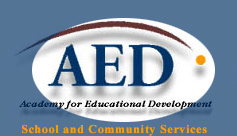
|
The Reviewing Students Work Documentation
Guidelines for RSW include the organization of teams and selection of student work samples, guidelines for discussion and how to document reviews.
Participant Roles explains the roles of faculty, principals, facilitators, coaches and district staff.
Note-taking form is used by individual teachers prior to a review
Documentation form helps teams track the evolution of the review process as well as the content of discussions over time.
Team planning guide is used by interdisciplinary teams of teachers to plan the focus and schedule of reviews.
Activity for setting review goals involves the entire school, or groups of faculty, to determine priorities for student learning.
Sample review Understand the process of reviewing student work by reading student work and excerpts from a review.
Links to related sites
|
|

|
.
- With the support of the Wallace- Reader’s Digest Fund, the Academy for Educational Development (AED) is collaborating with middle schools in two urban school districts in a three-year project focusing on teaching and learning. The goal of this project is to build the capacity of school faculties to improve the quality of instruction in middle-grades schools, through a continuous, comprehensive, and critical review of student work.
The approach recognizes that student work is a significant indicator of the effectiveness of instruction. AED assists faculties to review student work in a regular and rigorous manner thus forming a foundation for planning and implementing instructional improvements. Through discussions of shared expectations for student work, teachers develop school-wide standards for quality work.
- For more information, please contact:
Alexandra Weinbaum sweinbau@aed.org
Vice President School and Community Partnerships
Academy for Educational Development
100 Fifth Avenue, New York, NY 10011
(212)367-4577; Fax (212) 627-0407
AED's work is based on three underlying assumptions:
- Structured, regular reviews of student work provides opportunities to bring about substantial improvement in instruction through addressing such questions as: What constitutes quality in student work in various content areas? What instructional support will assist students in producing quality work? What resources--time, professional development, technical assistance--will help faculty to engage effectively in this work? What features of school organization need to be addressed to provide faculty with the time to do this work? What leadership and support from the school administration, district and external networks of peers will promote and sustain this work? Such questions inform the project and the discussions among teams of teachers in each participating school.
- Efforts to improve instruction and the quality of student work must include attention to providing equitable access to challenging curriculum and instructional support. The discussion of content and performance standards in student work raises important equity issues in most schools around the country. Chief among them is the challenge to provide all students access to rigorous and relevant curricula, along with the appropriate support to achieve high academic standards. Addressing these questions through reviewing student work and teacher assignments is a central feature of this project.
- Critical friends from outside a school can provide a catalytic effect on the school's ability to open its classrooms to peer review and reflection on student work and instruction. The supportive and critical perspective of peers trained in the review of schools and student work helps to break down the isolation of individual teachers, encourages dialogue among faculty about teaching and learning, raises standards and expectations for the work of students and teachers alike. The school review process provides staff with opportunities to visit other schools and review the work of students outside their school--a powerful opportunity for professional development.
|
Project Activities
- Professional development for teachers and administrators which prepares them to become facilitators of teams of teachers who meet regularly to examine student work and its relationship to instruction.
- Development of collaborative interdisciplinary teams which meet regularly to identify what they value in student work, refine approaches to assessment and instruction, and determine the effectiveness of their support for all students in reaching agreed-upon standards.
- Regular meetings including team facilitators, building administrators and AED staff and consultants to share information and learning and plan next steps in the project.
- Summer institute for teachers and administrators to learn how to conduct school reviews, with a focus on teaching and learning.
- Conduct school reviews in the second and third years of the project with teams composed of teachers and administrators from all schools.
- Networking within a school district and across districts: Members of the school community participate in various project activities; information is disseminated throughout the district; participants collaborate with AED staff in the creation of project products, for example a guide to reviewing student work; members participate in local and national conferences to share learning with colleagues.
|
Participating Schools and Districts
- School District of Philadelphia
(Overbrook Cluster Program)
Beeber Middle School
Lamberton Middle School
Overbrook Educational Center
- Plainfield, New Jersey Board of Education
Hubbard Middle School
Maxson Middle School
|
|